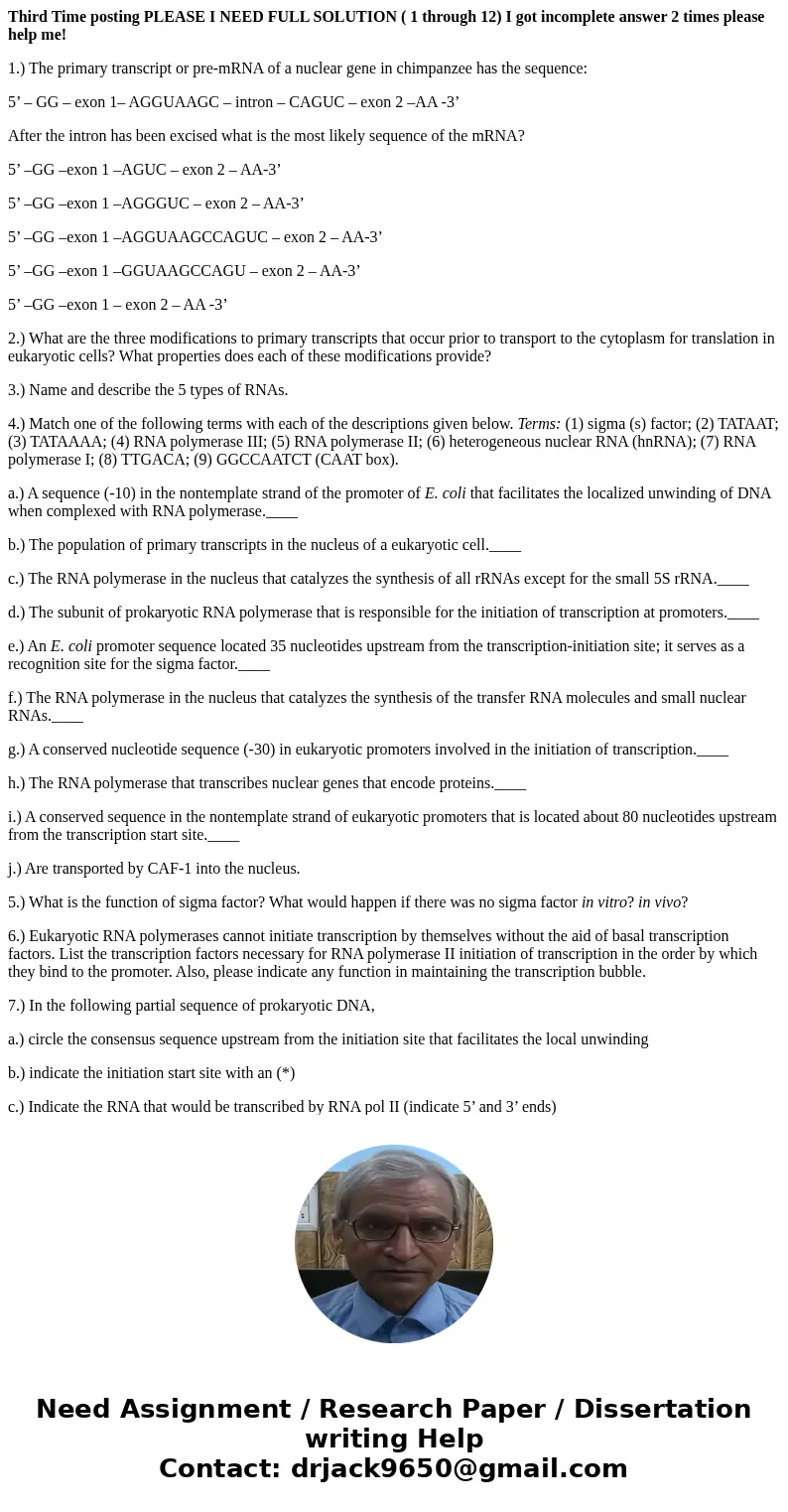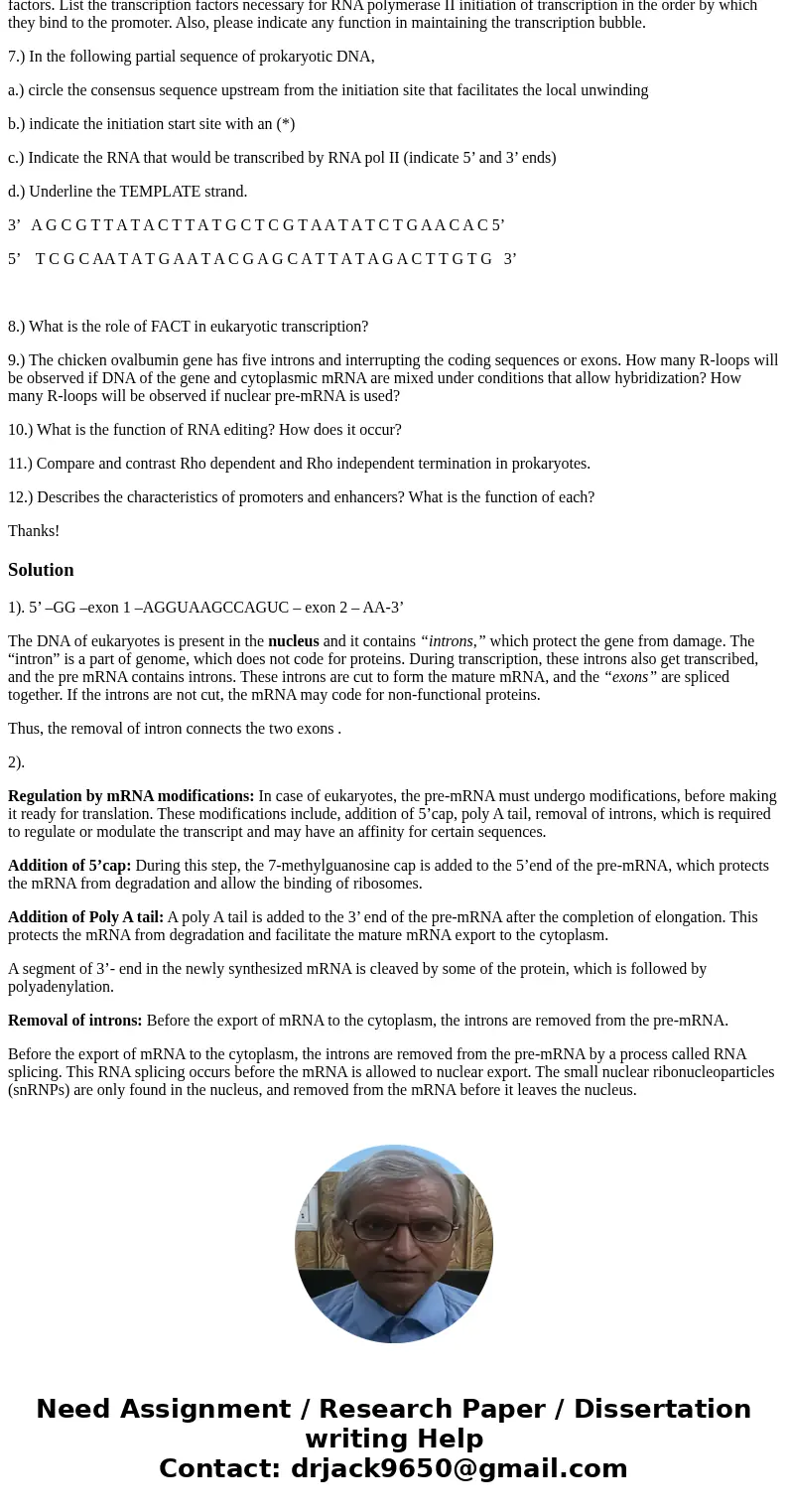Third Time posting PLEASE I NEED FULL SOLUTION 1 through 12
Third Time posting PLEASE I NEED FULL SOLUTION ( 1 through 12) I got incomplete answer 2 times please help me!
1.) The primary transcript or pre-mRNA of a nuclear gene in chimpanzee has the sequence:
5’ – GG – exon 1– AGGUAAGC – intron – CAGUC – exon 2 –AA -3’
After the intron has been excised what is the most likely sequence of the mRNA?
5’ –GG –exon 1 –AGUC – exon 2 – AA-3’
5’ –GG –exon 1 –AGGGUC – exon 2 – AA-3’
5’ –GG –exon 1 –AGGUAAGCCAGUC – exon 2 – AA-3’
5’ –GG –exon 1 –GGUAAGCCAGU – exon 2 – AA-3’
5’ –GG –exon 1 – exon 2 – AA -3’
2.) What are the three modifications to primary transcripts that occur prior to transport to the cytoplasm for translation in eukaryotic cells? What properties does each of these modifications provide?
3.) Name and describe the 5 types of RNAs.
4.) Match one of the following terms with each of the descriptions given below. Terms: (1) sigma (s) factor; (2) TATAAT; (3) TATAAAA; (4) RNA polymerase III; (5) RNA polymerase II; (6) heterogeneous nuclear RNA (hnRNA); (7) RNA polymerase I; (8) TTGACA; (9) GGCCAATCT (CAAT box).
a.) A sequence (-10) in the nontemplate strand of the promoter of E. coli that facilitates the localized unwinding of DNA when complexed with RNA polymerase.____
b.) The population of primary transcripts in the nucleus of a eukaryotic cell.____
c.) The RNA polymerase in the nucleus that catalyzes the synthesis of all rRNAs except for the small 5S rRNA.____
d.) The subunit of prokaryotic RNA polymerase that is responsible for the initiation of transcription at promoters.____
e.) An E. coli promoter sequence located 35 nucleotides upstream from the transcription-initiation site; it serves as a recognition site for the sigma factor.____
f.) The RNA polymerase in the nucleus that catalyzes the synthesis of the transfer RNA molecules and small nuclear RNAs.____
g.) A conserved nucleotide sequence (-30) in eukaryotic promoters involved in the initiation of transcription.____
h.) The RNA polymerase that transcribes nuclear genes that encode proteins.____
i.) A conserved sequence in the nontemplate strand of eukaryotic promoters that is located about 80 nucleotides upstream from the transcription start site.____
j.) Are transported by CAF-1 into the nucleus.
5.) What is the function of sigma factor? What would happen if there was no sigma factor in vitro? in vivo?
6.) Eukaryotic RNA polymerases cannot initiate transcription by themselves without the aid of basal transcription factors. List the transcription factors necessary for RNA polymerase II initiation of transcription in the order by which they bind to the promoter. Also, please indicate any function in maintaining the transcription bubble.
7.) In the following partial sequence of prokaryotic DNA,
a.) circle the consensus sequence upstream from the initiation site that facilitates the local unwinding
b.) indicate the initiation start site with an (*)
c.) Indicate the RNA that would be transcribed by RNA pol II (indicate 5’ and 3’ ends)
d.) Underline the TEMPLATE strand.
3’ A G C G T T A T A C T T A T G C T C G T A A T A T C T G A A C A C 5’
5’ T C G C AA T A T G A A T A C G A G C A T T A T A G A C T T G T G 3’
8.) What is the role of FACT in eukaryotic transcription?
9.) The chicken ovalbumin gene has five introns and interrupting the coding sequences or exons. How many R-loops will be observed if DNA of the gene and cytoplasmic mRNA are mixed under conditions that allow hybridization? How many R-loops will be observed if nuclear pre-mRNA is used?
10.) What is the function of RNA editing? How does it occur?
11.) Compare and contrast Rho dependent and Rho independent termination in prokaryotes.
12.) Describes the characteristics of promoters and enhancers? What is the function of each?
Thanks!
Solution
1). 5’ –GG –exon 1 –AGGUAAGCCAGUC – exon 2 – AA-3’
The DNA of eukaryotes is present in the nucleus and it contains “introns,” which protect the gene from damage. The “intron” is a part of genome, which does not code for proteins. During transcription, these introns also get transcribed, and the pre mRNA contains introns. These introns are cut to form the mature mRNA, and the “exons” are spliced together. If the introns are not cut, the mRNA may code for non-functional proteins.
Thus, the removal of intron connects the two exons .
2).
Regulation by mRNA modifications: In case of eukaryotes, the pre-mRNA must undergo modifications, before making it ready for translation. These modifications include, addition of 5’cap, poly A tail, removal of introns, which is required to regulate or modulate the transcript and may have an affinity for certain sequences.
Addition of 5’cap: During this step, the 7-methylguanosine cap is added to the 5’end of the pre-mRNA, which protects the mRNA from degradation and allow the binding of ribosomes.
Addition of Poly A tail: A poly A tail is added to the 3’ end of the pre-mRNA after the completion of elongation. This protects the mRNA from degradation and facilitate the mature mRNA export to the cytoplasm.
A segment of 3’- end in the newly synthesized mRNA is cleaved by some of the protein, which is followed by polyadenylation.
Removal of introns: Before the export of mRNA to the cytoplasm, the introns are removed from the pre-mRNA.
Before the export of mRNA to the cytoplasm, the introns are removed from the pre-mRNA by a process called RNA splicing. This RNA splicing occurs before the mRNA is allowed to nuclear export. The small nuclear ribonucleoparticles (snRNPs) are only found in the nucleus, and removed from the mRNA before it leaves the nucleus.


 Homework Sourse
Homework Sourse